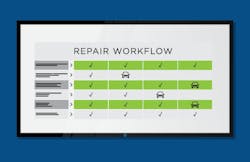Daniel Panduro, owner of Fix Auto Sun Valley in Sun Valley, Calif., who recently opened his second location in Victorville, Calif., in March 2017, learned the hard way what lack of communication can cause. And by hard way, it cost him $8,000 out of pocket.
His technician thought that the job entailed replacing a quarter panel on a BMW versus just repairing it. So, Panduro walked in the next day only to find a huge hole in the panel. It was too late to turn back.
And it all happened because the car wasn’t mapped properly, leading the tech to misunderstand what should be fixed. From that point on, Panduro, whose Sun Valley location brings in $3.5 million in revenue and has a monthly car count of around 170, established that would never happen again.
Since then, the shop’s vehicle mapping process has only become more thorough, but more importantly, has become part of a larger theme: nonverbal communication.
Nonverbals can come in many forms—from the way vehicles are mapped to a visual production board—but the greater purpose is to create a flow in your shop where everyone knows what they should be doing at all times, without ever physically speaking.
SHOP: Fix Auto Sun Valley LOCATION: Sun Valley, Calif. OPERATOR: Daniel Panduro SIZE: 40,000 square feet STAFF SIZE: 21 AVERAGE MONTHLY CAR COUNT: 150-170 ANNUAL REVENUE: $3.5 million
Both Panduro and Matthew McDonnell, owner of Big Sky Collision Center in Billings, Mont., A&D Auto Body Repair (Bozeman. Mont.) and Crash Repair Center (Livingston, Mont.) have the same philosophy: “If it’s not written, it doesn’t exist,” as Panduro says.
Instead of talking and having to track down the appropriate people, nonverbals allow everyone on the shop to be on the same page and have the necessary materials available at their disposal.
“With verbal communication, you always run the error of forgetting something that’s important,” McDonnell says.
They both share the processes they’ve implemented in their own shops, as well as some key tips to keep in mind when looking to either establish or strengthen your shop’s nonverbal communication.
Getting Started
As far as coming up with ideas for a system, Panduro and McDonnell share the same philosophy on this topic: Borrowing ideas from others is OK.
“Why would you ever be the one to reinvent the wheel?” McDonnell says. “When you ask somebody, ‘How did you do that?’—it’s the greatest compliment in the world.”
Panduro says that when you visit other shops, take an idea back with you and start implementing it.
For example, after visiting fellow Fix Auto shop owner David Caulfield’s shops in 2016, he implemented a similar segmenting system, where vehicles are separated into level one and two designations. Level one work typically entails jobs that are 25 hours or less and doesn’t involve mechanical, frame or structural work. Level two is heavy frame and structural work.
And while taking ideas is encouraged, Panduro says to make sure to adapt them to fit your shop and its culture. When you visit a shop and see that you’re not doing exactly what they’re doing, don’t think you have to overhaul your shop in the next week. Chances are, that implementation won’t stick.
Most importantly, he says not to be nervous to implement nonverbal communication. If anything, have some fun with it.
Tips for Starting a Nonverbal Process
McDonnell says there are some steps that a shop owner or operator should consider before getting the shop to jump on board with this type of communication.
-
Understand the system you want to put in. You have to sell it to your employees, so do your research. You have to be the cheerleader in the beginning, so know what you’re talking about when you deliver it.
-
Once you’ve established a system, explain it to your team. You can typically tell if your staff is buying in if there is enthusiasm for it. If so, they’re going to support it and take ownership over the idea. Even if it’s a great idea, if your staff doesn’t buy in, it won’t work. Just remember to never do things to your employees—do things with them.
-
Measure and track it. Once the system is put in place, you need to track the consistency. For example, if a file folder is following your vehicles, where are you putting it? Is it being placed on the dash every time? Make sure to monitor the consistency because that will play a part in the system actually sticking around.
“A good system can go to the wayside just because we didn’t put the effort in to make sure that we measured it and monitored it,” McDonnell says.
-
Enforce it amongst yourself and your team. Implementing a system and leaving it be isn’t enough. Make a daily conscious effort of using it.
The Basics: The Top Nonverbal Communication Systems
Both McDonnell and Panduro have multiple visual processes in place to help push nonverbals in their shops, but here are a few examples that work very well for them:
Extensive Vehicle Mapping: Panduro is proud of the thorough vehicle mapping that he has implemented in his shop. Marked on all the glass panels of the car with a water-based pen are the initials of the insurance carrier of the particular vehicle, the in date, out date, start date, RO number and any sublet labor is written on the windshield.
The mapping process takes place while the customer is still in the shop for several reasons. The first is to ask for permission to mark the car. Panduro says that explaining to the customer that you are giving your technicians visual instructions usually helps them understand why you’re doing it.
Two different colors are used to mark the damage on vehicles. Prior vehicle damage is marked in orange, while loss-related damage is marked with green. This is a direct way to establish with the customer and the technician what will be fixed and what won’t.
Depending on the insurer, photos are taken before or after the mapping. This process also helps eliminate one of Panduro’s pet peeves: rolled-down windows on the lot, which indicates to him that the mapping process wasn’t followed.
Color-Coded File Folders: For McDonnell, he says a big part of their nonverbal system is sharing file folders. In his shop, each job is given a file folder that is color coordinated according to the size of the job (ultra light, light, medium and ultra heavy).
The folder then follows the car during the entire repair process. The color on the folders works as a guide for the technicians to determine which jobs to take first.
It also aids in understanding which phase every car is in the repair process. The folders are filed in bins mounted along the office walls that are labeled. There are various labels for the bins, such as vehicles delivered and not yet billed, work completed and not yet delivered, total losses, and scheduled.
The shop’s schedule is also visual, as there are aligned bins to show a four-week view of the shop’s scheduled cars, as well as a four-plus week bin for cars that are waiting to get in.

